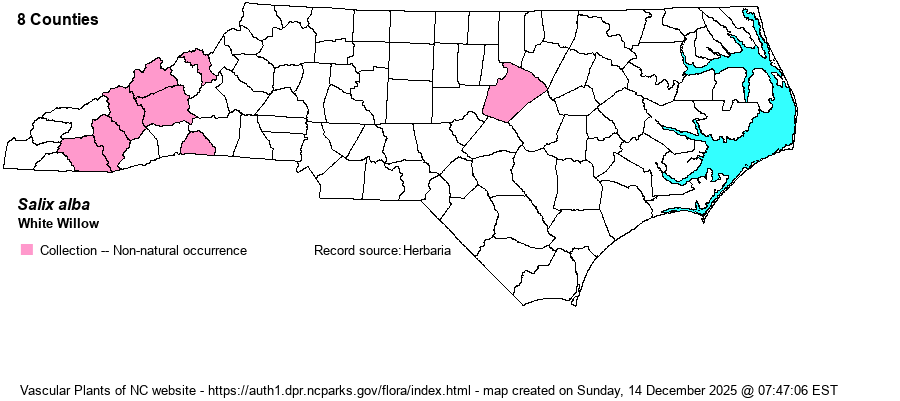| Author | L. | |
| Distribution | Almost exclusively in the Mountains; also Wake County.
Native of Eurasia; in N.A. much of southern Canada and the U.S. | |
| Abundance | Uncommon in the Mountains; rare in the Piedmont. | |
| Habitat | Nearly all specimens were taken from creeks, streams, and river shores; also shore of artificial lake and near a waterfall. | |
| Phenology | Flowering March-May. | |
| Identification | This willow is a tree that has leaves that are appressed silky/hairy beneath and with finely serrated margins. Crack Willow (S. x rubens) leaves are much more coarsely serrate. | |
| Taxonomic Comments | The genus Salix is a very large and complex group of plants that vary from ground-hugging Arctic belly plants to huge trees. There are 113 species in North America alone, including introduced species. They are extremely important to browsing mammals -- rabbits, deer, elk, muskox, moose, many rodents -- and browsing birds like ptarmigan. Many birds use them to nest in. Here in NC we only have a small number of native species (5) and so do not appreciate the ecological importance of willows. We highly recommend reading the introductory pages of George Argus's FNA treatment (2010) and his excellent monograph on the willows of the southeastern U.S. (1986). The latter has drawings and descriptions of all southeastern U.S. taxa. Due to natural and horticultural hybridization, some plants will not key cleanly and you may have to compare your specimen with others verified by Argus. | |
| Other Common Name(s) | | |
| State Rank | SE | |
| Global Rank | G5 | |
| State Status | | |
| US Status | | |
| USACE-agcp | FACW link |
| USACE-emp | FACW link |

